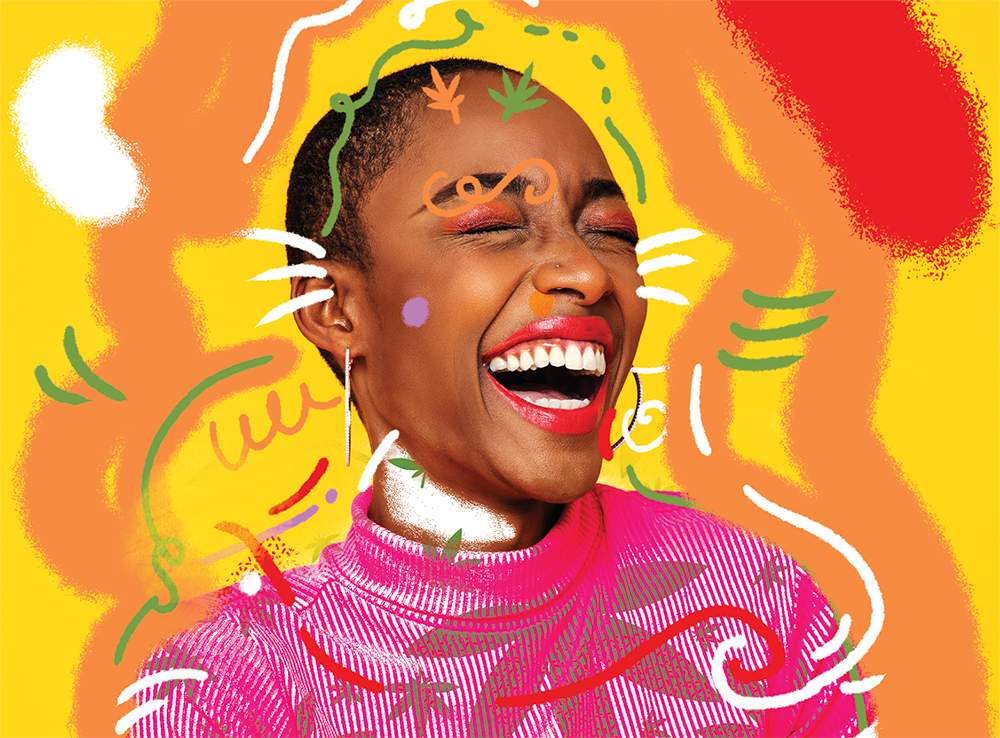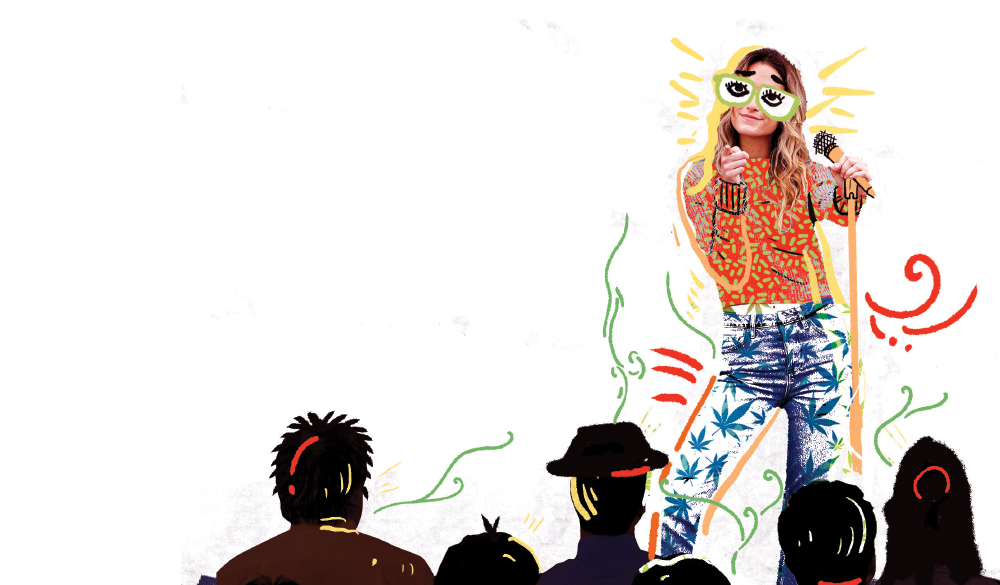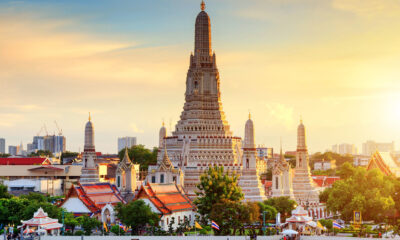
Published
2 years agoon
MOST WORKPLACES COULD do with a bit more humor. Not only does it boost mood and morale, but levity can enhance team performance and even your bottom line. Here are some simple tips and strategies from the worlds of cannabis, comedy and academia for bringing the funny.
Stop us if you’ve heard this one, but the list of benefits from fostering an environment of levity in the workplace is staggering:
It boosts sales and productivity. It makes advertising memorable. Leaders who use humor appear more competent and likeable. It transforms training and chores into something enjoyable, increases employee retention and attracts eager new hires.
It flattens hierarchies, enhances collaboration, heightens bonding and encourages people to take positive risks. Humor lowers stress, builds resilience, reduces hostility, deflects criticism, improves morale, creates engagement and helps management communicate difficult messages.
Humor essentially costs nothing and provides terrific returns—indeed, a 2011 study by researchers at Pennsylvania State University found that a good laugh activates the same regions of the brain that light up over a fat bonus check. Perhaps best of all, it makes coming into the store or office more enjoyable for everyone.
So what’s the punch line? The rather depressing one is that many bosses and workers, especially those in more “professional” settings, think humor is a bad idea … at least in their particular circumstances, at their particular place of work. And that mindset is growing.
In both the workplace and society, we are increasingly shying away from levity. According to some studies, we spend about a third as much time laughing as people did in the 1930s. Another study found that 90 percent of corporate emails are completely devoid of humor, not even a chirpy sign-off.
AdvertisementFEARING
THE FUNNY
What could explain this? There are three main reasons, all of which you can probably guess. First, humor is often viewed as inappropriate for the serious discourse of business, particularly in health and wellness industries like cannabis. Second, it’s hard for many of us to do comedy well (it can feel like a divinely bestowed gift—you were either the funny kid in school or you weren’t). Third, it’s dangerous. Jokes are about a shared view of the world, an understanding of the same cultural and linguistic touchpoints and, crucially, a willingness to violate the same norms and laugh at the same things. When they bomb, it’s ostracizing. If a quip or story is viewed as offensive, it can damage the teller’s professional standing by making them appear lacking in judgement and intelligence, or worse, possibly even bigoted or sexist.
“The violating nature of humor is what makes it risky,” says Maurice Schweitzer, a professor of business at the University of Philadelphia’s Wharton School and the author of several studies on workplace humor. “Jokes that go too far over the line of appropriateness cause an ‘eeeek’ reaction. Rather than thinking that the joke teller is intelligent and competent (as happens when someone lands a good one), observers think, ‘What an idiot!’ Or, ‘I can’t believe he just said that!’”

In short, humor is one more wonder drug that can kill you. It’s not unwise to be wary of its power.
The argument for avoiding humor because it somehow betrays your professionalism is widespread. But in contrast to the very real risk in telling jokes, that view is built mostly on falsehoods. “The research is clear: Humor can be one of the most powerful tools we have for accomplishing SERIOUS things. Gravity and levity aren’t at odds,” says behavioral scientist Jennifer Aaker, co-author of Humor, Seriously: Why Humor Is a Secret Weapon in Business and Life.
Indeed, there’s a good argument that the higher the stakes, the more we need humor. (See: Ukraine president Volodymyr Zelenskyy’s response to Washington’s offer to evacuate him: “I need ammo, not a ride.” The stakes don’t get much higher than facing an invading Russian army.)
SMILES SOLD
HERE
Even in much more routine situations—on a sales call or on the dispensary floor—a little humor can do wonders, like easing a new employee’s anxiety or lowering a customer’s defenses.
“When people smile and laugh at work, it increases employee engagement, retention and likability. Just like everything in life, where your effort goes is what will grow,” advises the HR training team at Green CulturED, a Denver, CO-based cannabis industry training and e-learning firm. “The same is true for humor in the dispensary workplace. You don’t want to be like an old dinosaur boss—you want to be intentional about people laughing at work.”
Adds David Belsky, CEO of Manhattan Beach, CA-based cannabis recruiting agency FlowerHire: “Employees who feel good about going to work every day are more likely to feel inspired at work, be committed to the work they’re doing, bring new and innovative ideas to your company and stay with your company long-term.”
Or take it from former Google and Alphabet chairman Eric Schmidt, who says, “I’ve learned, often the hard way, that the best way to be taken seriously is to not take yourself too seriously.”
In your own business, think of a budtender on her first day on the job. Or a new patient recently diagnosed and prescribed cannabis for an ailment. They’re likely feeling out of their depth and perhaps even anxious and intimidated. Cheerless, all-business engagement from you or your staff may make them feel even more overwhelmed.
“Individual happiness directly affects employee engagement, job satisfaction and organizational commitment,” the Green CulturED team notes. “The question to ask is: What can we do to make and keep our talent happy?
“There are many answers to this challenging question, but one should be using humor in the workplace because it means more people are laughing and smiling at the cannabis dispensary. When people laugh, they are expressing happiness verbally, and a smile shows how they are feeling on the inside.”
Humor is also the most sure-fire way to communicate ideas to people and have them actually pay attention, says cannabis meme creator Branden Hampton, who co-owns WeedHumor.com and runs @Weedhumor on Twitter and Instagram.
“Since 2012, we’ve been remixing, parodying and captioning popular images and videos to create humorous, cannabis-related memes,” Hampton says. “But aside from making people laugh, they express ideas, frame problems, share user experiences and deal with important social, political and cultural issues surrounding marijuana use in our society.”
Sales trainer Jeffrey Gitomer agrees that levity is the key to capturing people’s attention. “Humor makes you likable and people want to buy from people they like because they trust them and have more confidence in them,” he says. “The end of laughter is followed by the height of listening.”
Or as Green CulturED’s humorists note: “We always say the best place to use humor is just before your key message or call to action.”
THE BEST JOKE THAT
WAS NEVER TOLD
But I’m not that sort of funny, you say. Few of us are. Mercifully, it’s not that hard to get better.
Humor is a skill, which means it can be learned. And besides, you don’t need to be professional comedian-level funny, you just need to be funnier than the dour dispensary owner down the road.
“Just as you don’t need to be Phil Mickelson to do well at the company golf outing, you don’t need to be Amy Schumer, Ali Wong or John Mulaney to use humor well in the workplace,” write Brad Bitterly and Alison Wood Brooks in Sarcasm, Self-Deprecation and Inside Jokes: A User’s Guide to Humor at Work.
Studies even show that something as simple as adding a lighthearted line at the end of a sales pitch—like, “My final offer is X and I’ll throw in my pet frog”—can increase customers’ willingness to pay nearly 20 percent more.
“Really let it sink in how bad that joke is. The bar is so low,” says Aaker’s co-author, Naomi Bagdonas.
Dr. Robert Provine, a neuroscientist at the University of Maryland and probably the world’s leading laughter scientist, has spent most of his professional life collecting examples of the most hilarity-inducing lines in conversations. Brace yourself.

They are: “I know.” “I’ll see you guys later.” “I see your point.” “It was nice meeting you.”
Such lightly sarcastic lines, when dropped into conversations with good timing, can instantly spark smiles. This points to a truth about everyday humor—it’s often little more than a mindset or attitude.
“The funny thing about humor is that we don’t need to tell a joke to get a laugh. It can be enough simply to not take yourself too seriously,” notes business communication expert Carmine Gallo in The Story Teller’s Secret.
Bagdonas concurs: “This is not about becoming a comedian, it’s about looking at the world in a different way. And the good news is that our lives are already full of humor if we only notice. When we live our lives on the precipice of a smile, we shift how we interact with the world.”
There is another benefit to taking such an active approach to humor—it makes you more aware of the many little things going on in life, and when searching for the humorous spin, you are also searching for the positive, even in the worst things that happen. As the old saying goes, comedy is just tragedy plus time. What’s a disaster today is great material tomorrow.
For Mark Twain, humor wasn’t some optional extra. It was the key to a good life. “Humor is the great thing. The saving thing. The human race has only one really effective weapon and that is laughter,” he wrote.
In the following pages, we provide tips from your fellow cannabis operators and professionals, as well as from comedians, academics and authors that will hopefully allow you to up your humor game, and your business operations as well.
AdvertisementLEAN INTO
CANNABIS
When it comes to putting smiles on folks’ faces, those of us working in cannabis have a pretty big head start over most other industries. There is a literal secret ingredient to our propensity to appreciate the lighter side of life! Many of the funniest comedians, cartoonists and writers famously partake in our product. Lean into this wonderful aspect of your chosen business when boosting the levity levels in the workplace. If you’re like 45 percent of our GCT Brain Squad (see Buzz Session, p. 64), you allow employees to use product during work hours. If that’s not your bag, you might host special onsite happy hours after work where staff gets to sample the wares and share some laughs.

KEEP A
JOURNAL
Keep “A Funny Thing Happened on the Way to Work” file or journal to write down humorous things or events so you can remember them. It’s an assignment all Aaker and Bagdonas students are given at Stanford. “All that you do is, you go through your day and you jot down any moment when you laughed, or any moment when you had shared laughter,” Aaker says. Typically, their students report experiencing much more joy and laughter in their lives by the seventh day of this practice, she says.
TELL
STORIES
The safest humor involves personal stories because they are guaranteed to be original. And they can be practiced and perfected in your own highly personalized style. Keep in mind there’s nothing funny about a confident person who’s doing well.
The best stories involve the times when life threw you a banana peel. You breaking a new $200 glass bong right out of the package is not funny today … but it will be when you get to Vegas for a trade show and talk shop with other store owners. As the late humorist Jeanne Robertson wrote in Don’t Let the Funny Stuff Get Away, humor is not about one-liners or being able to tell jokes, it’s about accepting things about yourself that can’t be changed and finding the humor in the situations around you. Final key technical point: Crafting a funny story involves knowing the ending and working backward. Keeping the punchline in mind will help you determine which details are essential for your story. If it doesn’t directly set up your punch line, cut it.

LOOK FOR TRUE,
NOT ‘FUNNY’
If you want to have more humor in your life, don’t look for what’s funny, just look for what’s true, says Stanford Business School lecturer and Humor, Seriously co-author Bagdonas. “So become an observer of your life. Look for little oddities or incongruities. It’s not about being funny per se but using humor in small intentional ways. Just look around your life and notice the simple, true things.” The late, much missed comedian Mitch Hedberg was a master at this sort of observational humor, finding the silliness in everyday items like straws and donuts, flipping clichéd language around to expose its absurdity and inspiring a generation of stoner comics from Eric Andre to Hannibal Burress. Such an approach also leverages the psychological principle of priming—our brains are wired to see what we’ve been set up to expect, so delivering the unexpected instead is a fast track to making people laugh. Start looking for the humorous and you’ll find it everywhere. In your commute, in your efforts to bring life to heel, in the mirror.
COMEDY IS
WRITING
Everyone knows that comedy is essentially a combination of what you say and how you say it—your material and your delivery. The often unmentioned third element is how you write it. Explaining his creative process to podcaster Tim Ferriss last year, Jerry Seinfeld spoke of first getting the germ of an idea for a joke he does about how people apologize for dropped phone calls. He used it as an example of how he writes and rewrites his material. “[T]hat to me is like an archery target, 50 yards away. Then I take out my bow and my arrow and I go, ‘Let me see if I can hit that. Let me see if I can create something that I could say to a room full of humans in a nightclub, that will make them see what I see in that.’ There’s something stupid and funny about [people apologizing for complex technology out of their control] to me. That’s the very, very beginning. So then I’ll write something about it. It’ll be, if I’m lucky, it’ll be a half a page or a page on a yellow legal pad and I’ll write that. Then in the session the next day, if I get around to it, I will see it again and I will see what I have and what I like and I don’t like. And as any writer can tell you, it’s 95 percent rewrite.”

THE RULE
OF THREES
Three is the smallest number of elements required to create a pattern. Because of that, lists of three have a cadence that is pleasing to us. Once you start looking for this formula, you’ll see it everywhere (“Life, Liberty and The Pursuit Of Happiness,” “Blood, Sweat and Tears,” “Sex, Drugs and Rock ’n’ Roll”). Lists of three work especially well in humor when instead of a third similar element, the pattern ends with something unexpected. “Blood, Sweat and … Cleanup on Aisle 5!” “Audiences are trained to laugh at the third item. It’s strange but true,” says David Nihill, author of Do You Talk Funny.
KEEP IT
SHORT
Comedy is in the details but you don’t want to overdo it, says San Francisco comic Reggie Steele: “Just enough to set the scene.” Adding descriptive language should be approached “as if you were talking to a blind person,” he says. In Eddie Murphy’s breakout 1983 “Delirious” standup special for HBO, he warned students in the audience that they would be tempted to try to recreate his longer material in the schoolyard the next day … and it wouldn’t work. Instead, he offered up his famous “bear and rabbit” joke as a simple, short, easy-to-recreate bit that anybody could manage.
START
SMALL
As you embark on your journey to find and share the funny, take tiny steps—your brain works better and you make better choices when you’re in your comfort zone. Make one funny observation that’s worked for you consistently in the past rather than trying to do a whole routine. You’re likely to approach customers more positively when it’s in a situation where you’ve had success before, writes Marcus Buckingham in The One Thing You Should Know.
AND YES,
TRY IMPROV
Speaking and presentation coach Darren LaCroix says there are three keys to improving humor delivery—location, location, location. Did we mention that the location is an improv stage? Humor workshops for businesspeople, and especially improv clubs, have exploded in recent years. It turns out that taking that leap to being willing to look silly and exposed in front of strangers has major benefits. And those benefits go beyond your primary goal of getting more comfortable with public speaking. One MIT study found that a group of improv comedians generated 20 percent more ideas than professional product designers did. Practicing improv develops your ability to create in all sorts of ways. And on top of a tougher skin, improv teaches specific techniques to think faster and funnier on your feet, as well as being a better partner in patter for others on your team.

LEVERAGE
EXISTING RITUALS
Not all humor needs to be of the high-stakes interpersonal type. It can be inserted in the small existing rituals of a business. Explains Bagdonas: “Often a manager can think, ‘Oh gosh, I have to do something totally big and bold and new to create some levity here.’ When actually, sometimes the more effective way is to ask, what are the rituals you already have? Are there team communication channels? Are there all-hands or daily standup meetings? And could you add a little bit of humor into those?” This can include anything from using light-hearted sign-offs in emails to getting staff to play “two truths and a lie” at monthly meetings.
The Wall Street Journal recently reported about the “corporate jargon days” that employees at consultancy Silver Lining held on a monthly basis when they tried to use as much vague, bureaucratic language as possible. The goal: to goad the group to break the buzzword habit. “Before going to lunch, we would joke about having a three-hour strategy session to do a SWAT analysis of Subway vs. McDonald’s, considering how we could all get into alignment and move forward together as a team,” an employee told the paper. After the lesson was absorbed, they dropped the ritual.
REHEARSED
SPONTANEITY
The bits comics do on stage have the feel of something raw and spontaneous. But good comics leave nothing to chance: every word, sentence and gesture has been rehearsed and tested to find where the best laugh lines are. Yes, there are naturally funny people. But to get better, even the funniest require practice. Find a space at home or work and tell your stories while recording them. “If it makes you laugh even a little on playback, then you have something good to work with,” says Nihill. True, you’ll probably hate the sound of your own voice, but you’ll get used to it. The family dog can make a good first audience. But soon you’ll want to run your material by co-workers, trusted friends or old customers to see if they’re actually funny to others and not just Fido. “If most of [your test audience] laugh, keep it for your repertoire; if the majority groan, drop it. You’ve saved yourself some future pain,” Nihill writes.
CONTEXT
MATTERS
Any rules of thumb for using humor must include a caveat: context matters. Conversational dynamics can vary profoundly from person to person, group to group and situation to situation. These factors are tricky to navigate and make it difficult to know whether your humor attempt is being helpful or a distraction. (And when you’re the boss, staff will often laugh politely even if something isn’t funny or is in poor taste, creating an unreliable feedback loop. The Office, both British and American versions, played up that dynamic to tremendous effect.) A joke can work even in a somber situation if it genuinely relieves tension rather than adding to it. But a boss who jokes after a round of layoffs that he’s going to have to get a smaller yacht is likely to come across as insensitive and tone deaf, says Andrew Tarvin, a New York City workplace coach and author of Humor That Works. “Before you try to say something humorous, try to determine the type of person you’re addressing—the wrong humor will sink you as fast as the right humor will boost your chances of a sale,” he says.
NOT TO BE
X-IST, BUT …
Here’s a handy rule for jokes not to tell. If you ever have to open your joke with the phrase, “Not to be racist/sexist/homophobic/etc.” … just don’t. Don’t finish that sentence. Don’t tell the joke. You have already established for yourself why it is a very bad idea to deliver this thought to others.
MAKE FUN OF
PEOPLE CORRECTLY
In other words, make fun of what people do, not who they are. If you’re on the fence about whether to say a joke, don’t use Louis CK as your guide, says Bagdonas. “Don’t ask yourself, ‘Will this make me sound funny?’ Instead ask, ‘How will this make other people feel?’ The goal isn’t to get a laugh, it’s to connect, to make people feel lighter and more at ease.” Most people know the taboos: divisive, racist, ethnic, sexist etc. jokes are out. Not only do you risk losing a sale or your employees’ good will, you could damage the reputation of your business (and if the joke constitutes harassment, find yourself on the wrong end of a lawsuit). But you need to go further than simply watching out for someone’s background or identity. “Don’t punch down. So that means never making fun of someone of lower status,” says Aaker. Bosses, don’t bully your subordinates with “humor” that belittles them! Finally, check your distance—how close are you to the person you are making fun of? “I can make fun of my mother but not your mother,” Aaker says.
AdvertisementKNOW YOUR
HUMOR STYLE
Bagdonas and Aaker contend that everyone has (at least) one of four humor styles:
- Stand-Up: Bold, irreverent, and unafraid to ruffle a few feathers (Example: Wanda Sykes)
- Sweetheart: Earnest, understated, uses humor that lightens the mood (Example: James Cordon)
- Sniper: Edgy, sarcastic, nuanced—master of the dig (Example: Michelle Wolf)
- Magnet: Expressive, charismatic and easy to make laugh (Example: Jimmy Fallon)
To determine your category, take their test at Quiz.humorseriously.com.
“The more you understand everyone’s styles, the easier it is to read the room and know when to drop that perfectly timed frog joke,” says Aaker. You’ll also be better able to mitigate risks. For example, sweethearts and magnets need to watch out for excessive self-deprecation that can undermine their reputations, while standups and snipers have to make sure they don’t offend or alienate.”
BOUNCE
BACK
You will tell bad jokes. You will attempt humor that fails. Everyone who tries, crashes from time to time. The first rule when a joke of yours bombs is, don’t double down. Don’t repeat the joke, thinking people must not have heard it correctly. They most likely did. And don’t explain it. Instead, skilled humorists quickly turn the joke on themselves, says Michael Kerr, a workplace trainer and author of The Humor Advantage. After bombing, you might quip (warmly, not with hostility): “It takes a special human being to do what I just did.” Or “Thanks, I’ll be here all day!” As for those times when you cross the line and say something inappropriate, “that’s a very different scenario,” says Bagdonas. “The most important thing is to genuinely acknowledge it and get curious about your blind spot. Where was the empathy-fail that led you to this humor fail? Strive to learn from it and not make the same mistake in the future.”
BE
INCLUSIVE
Inside jokes can signal closeness or camaraderie, making people feel pleased to be in the loop. But they can also draw fault lines in an organization, making some people feel awkward and excluded. The research on this kind of humor is clear: When group cohesion is important, tell jokes that everyone can understand.
IN ADS, USE HUMOR
THAT HAS A POINT
Our brains don’t like or recall boring things. But funny things are remembered. Some of the most memorable—and thus, effective—advertising is really, really funny. There are two main things to keep in mind when going for a humorous approach in your advertising: 1) Studies show factual claims in humorous ads may not be taken as seriously by audiences; and 2) the humor needs to reinforce the principal point of your ad. “Here’s the litmus test,” says Wizard of Ads author Roy H. Williams: “If remembering the humor forces you to recall the message of the ad, the humor is motivated. Good job. But if recalling the humor doesn’t put you in memory of the ad’s main point, the humor is unmotivated and will make your ad less effective. Sure, people will like the ad. They just won’t buy what you’re selling.”
PRACTICE
WITH BOTTLES
Comedian Matt Morales recommends practicing your sales presentation or pitch with a bottle in each hand to get accustomed to speaking with your hands out in front of you. This positioning of your hands looks natural but initially it won’t feel comfortable. Work this method until you no longer feel like an awkward robot with your hands.

IT’S OKAY TO
CHICKEN OUT …
If you don’t think you can land jokes at work, or you’re too nervous to try, that’s okay. Not everyone is meant to be funny, just as not every attempt at humor will be successful. (Even professional comedians have bits that bomb.) But you can still incorporate levity into your worklife by doing something simple: appreciating other people’s humor, say Bitterly and Brooks. “Be quick to laugh and smile. Delight in the absurdity of life and in the jokes you hear. A life devoid of humor is not only less joyful—it’s also less productive and less creative, for you and for those around you.”

Chris Burslem is Group Managing Editor at SmartWork Media.
SPONSORED VIDEO
Going Global - Pioneering Cannabis Hospitality: A Conversation with Arend Richard
In this enlightening interview, Arend Richard, a seasoned entrepreneur from the cannabis industry, shares his journey from starting a YouTube channel to educate on cannabis use, to co-founding WeedTube, and developing a unique cannabis hospitality business. Born and raised in Colorado, Aaron discusses the evolution of his business ventures and his current project—creating a welcoming, educational environment for both seasoned and first-time cannabis users. He delves into the challenges of establishing a cannabis-friendly social space, including regulatory hurdles and community engagement, and highlights his vision for a new kind of social interaction centered around cannabis.
You may like
Promoted Headlines

Going Global – The Future of Cannabis Lounges: Insights from Christopher LaPorte of Reset

2024 Global Cannabis 50

Going Global – Pioneering Cannabis Hospitality: A Conversation with Arend Richard
Most Popular
-

 Cover Features11 months ago
Cover Features11 months agoHouse Party
-

 Cover Features11 months ago
Cover Features11 months agoThe Interview with Kristi Palmer
-

 Legal9 months ago
Legal9 months agoIs Germany on the Verge of Legalizing Recreational Cannabis?
-

 Branding10 months ago
Branding10 months agoThe Global Cannabis Times Interview with Kristi Palmer, Kiva Confections Co-Founder
-

 Products9 months ago
Products9 months agoMust List: The Best Infused Beverages Money Can Buy
-

 Business12 months ago
Business12 months agoBlazing Sales for New York’s First Legal Weed Retailer
-

 Branding12 months ago
Branding12 months agoCuraleaf’s Liquid Diamonds Bling
-

 Podcasts11 months ago
Podcasts11 months agoThe first cannabis flower prescription on the NHS with Mike Roberts











